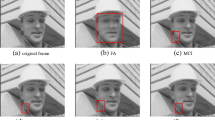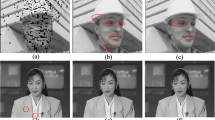Abstract
With the advances in digital video technology, it is becoming easier to forge the digital video without introducing any artificial visual trace. The temporal domain of the digital videos is one of the main targets of video tampering, and video frame-rate conversion is one of the common operations for temporal video tampering such as temporal splicing and video speed adjustment. This operation necessarily accommodates temporal interpolation that introduces the periodic motion artifact on the motion trajectories. In this paper, the frame-rate converted video detection method is proposed based on the motion artifact. The experimental results demonstrated the performance of the proposed method through the extensive experiments on 1300 original videos and 18,000 frame-rate converted videos in uncompressed and H.264/AVC formats. Especially, for the nearest neighbor and motion-based interpolation, the proposed method could detect over than 93.35% of the frame-rate up-converted videos while exhibiting 0.01 false positive rate.






Similar content being viewed by others
References
Ascenoso J, Brites C, Pereira F (2005) Improving frame interpolation with spatial motion smoothing for pixel domain distributed video coding. In: 5th EURASIP Conference on Speech and Image Processing, Multimedia communications and Sevices, pp. 1-6. Citeseer
Barron JL, Fleet DJ, Beauchemin SS (1994) Performance of optical flow techniques. Int J Comput Vis 12(1):43–77
Bestagini P, Battaglia S, Milani S, Tagliasacchi M, Tubaro S (2013) Detection of temporal interpolation in video sequences. 2013 I.E. Int Conf Acoustics, Speech Signal Process: 3033–3037. doi 10.1109/ICASSP.2013.6638215
Bian S, Luo W, Huang J (2014) Detecting video frame-rate up-conversion based on periodic properties of inter-frame similarity. Multimed Tools Appl 72(1):437–451
Bouguet JY (2013) Pyramidal implementation of the lucas kanade feature tracker description of the algorithm. Cit’e en: 69
Castagno R, Hassvisto P, Ramponi G (1996) A method for motion adaptive frame rate up-conversion. Circ Syst Video Technol, IEEE Trans 6(5):436–446
Center for image processing research sequences. URL http://www.cipr.rpi.edu/resource/sequences/. (last access: Oct. 2015)
Chen M, Fridrich J, Goljan M, Luka’ˇs J (2007) Source digital camcorder identification using sensor photo response non-uniformity. In: Electronic Imaging 2007, pp. 65,051G– 65,051G. International Society for Optics and Photonics
Choi BD, Han JW, Kim CS, Ko SJ (2007) Motion-compensated frame interpolation using bilateral motion estimation and adaptive overlapped block motion compensation. Circ Syst Video Technol, IEEE Trans 17(4):407–416
Choi BT, Lee SH, Ko SJ (2000) New frame rate up-conversion using bi-directional motion estimation. Consumer Electro, IEEE Trans 46(3):603–609
Dash dataset at itec/alpen-adria-universita¨t klagenfurt. URL http://www-itec.uni-klu.ac.at/dash/?page_id=207. (last access: Oct. 2015)
Farid H (2009) Image forgery detection. Sign Process Mag, IEEE 26(2):16–25
Farid H, Simoncelli EP (2004) Differentiation of discrete multidimensional signals. Imag Process, IEEE Trans 13(4):496–508
Fridrich J (2009) Digital image forensics. Sign Process Mag, IEEE 26(2):26–37
Gallagher AC (2005) Detection of linear and cubic interpolation in jpeg compressed images. In: Computer and Robot Vision, 2005. Proc 2nd Can Conf: 65–72. IEEE
Horn B (1986) Robot vision. MIT press
Kirchner M (2008) Fast and reliable resampling detection by spectral analysis of fixed linear predictor residue. Proc 10th ACM Workshop Multimed Sec: 11–20. ACM
Luka’ˇs J, Fridrich J (2003) Estimation of primary quantization matrix in double compressed jpeg images. Proc Digit Forensic Res Workshop: 5–8
Mahdian B, Saic S (2007) On periodic properties of interpolation and their application to image authentication. In: Information Assurance and Security, 2007. IAS 2007. Third Int Symp: 439–446. IEEE
Milani S, Fontani M, Bestagini P, Barni M, Piva A, Tagliasacchi M, Tubaro S (2012) An overview on video forensics. APSIPA Trans Sign Inform Process 1:e2
Paul RT (2011) Review of robust video watermarking techniques. IJCA Special Issue Computat Sci 3:90–95
Popescu AC, Farid H (2005) Statistical tools for digital forensics. In: Information Hiding, pp. 128–147. Springer
Simoncelli EP (1999) Bayesian multi-scale differential optical flow
Stamm MC, Lin WS, Liu K (2012) Temporal forensics and anti-forensics for motion compensated video. Inform Forensics Sec, IEEE Trans 7(4):1315–1329
Video trace library yuv video sequences. URL http://trace.eas.asu.edu/yuv/. (last access: Oct. 2015)
Wang Z, Bovik AC, Sheikh HR, Simoncelli EP (2004) Image quality assessment: from error visibility to structural similarity. Imag Process, IEEE Trans 13(4):600–612
Wang W, Farid H (2007) Exposing digital forgeries in interlaced and deinterlaced video. Inform Forensics Sec, IEEE Trans 2(3):438–449
Acknowledgements
This work was supported by the National Research Foundation of Korea(NRF) grant funded by the Korea government(MSIP) (No. 2016R1A2B2009595), and by the Institute for Information & communications Technology Promotion (IITP) grant funded by the Korean government (MSIP) (No.R0126-16-1024, Managerial Technology Development and Digital Contents Security of 3D Printing based on Micro Licensing Technology).
Author information
Authors and Affiliations
Corresponding author
Rights and permissions
About this article
Cite this article
Jung, DJ., Lee, HK. Frame-rate conversion detection based on periodicity of motion artifact. Multimed Tools Appl 77, 6095–6116 (2018). https://doi.org/10.1007/s11042-017-4519-y
Received:
Revised:
Accepted:
Published:
Issue Date:
DOI: https://doi.org/10.1007/s11042-017-4519-y




